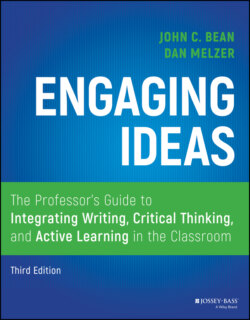Читать книгу Engaging Ideas - John C. Bean - Страница 59
Create Cognitive Dissonance for Students
ОглавлениеAccording to Meyers (1986), “Students cannot learn to think critically until they can, at least momentarily, set aside their own visions of the truth and reflect on alternatives” (27). A good way to promote this process is to create what psychologists call cognitive dissonance, which undermines students' confidence in their own settled beliefs or assumptions. Research in neuroscience, as summarized by Zull (2002), offers a material explanation for how cognitive dissonance helps restructure neuronal networks in the brain. Zull explains how knowledge exists as elaborate networks of neurons and synapses. Because learners build new knowledge on existing neuronal networks, these existing networks must be partially dismantled if the learner is to create new networks that embrace fuller, more detailed knowledge. To encourage new networks, Zull recommends assignments that help students dismantle an older mistaken or inadequate view. Thus in a first‐year seminar in cultural studies, students might be asked to write a thinking piece on alternative views of hip‐hop as revealed in Imbram X. Kendi's (2019) How to Be an Antiracist:
Thinking Piece Task: When Kendi was a teenager, his parents and grandparents warned him of the dangers of hip‐hop, expressing a view similar to that of linguist John McWhorter: “By reinforcing the stereotypes that long hindered blacks, and by teaching young blacks that a thuggish adversarial stance is the properly ‘authentic’ response to a presumptively racist society, rap retards black success” (87). How does this view differ from Kendi's own experience with the hip‐hop scene on the Ave in Jamaica Queens? To what extent does Kendi's distinction between assimilationists (who discourage hip‐hop) and antiracists cause you to rethink any of your ideas about structural racism?
Another strategy is to create “decentering” tasks that encourage students to see a phenomenon from an unfamiliar perspective. Here is an example of a possible thinking piece assignment from nursing:
Most public discussion of the coronavirus has focused on the medical model of infectious diseases concerned with the pathology of COVID‐19, methods of transmission, advances of treatments, and search for vaccines. However, in the founding days of modern nursing, Florence Nightingale championed an environmental/miasma model of infectious diseases. Based on your understanding of Nightingale's writings, how might public discussion of the coronavirus differ today if more emphasis were placed on her theories?
Still another approach is to ask students to play what Peter Elbow calls the “believing and doubting game” (1973, 147), a strategy that we explain in detail in chapters 8 and 9. The believing/doubting game—like other heuristic exercises based on pro/con brainstorming—is specifically designed to induce cognitive dissonance. The point of all these strategies is to present students with conflicting interpretations of material and to encourage them to confront the inadequacies and contradictions lying dormant in the views they bring to college.
